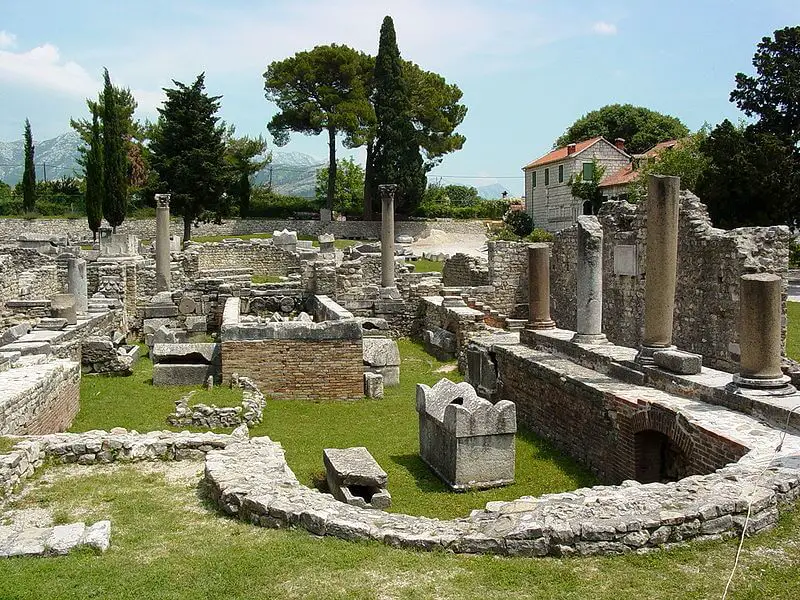Split Map And Guide of Diocletian’s Palace
- Additional self guided walking tours include:
- Walking tour and guide to Old Town Split and Marjan Hill
- Explore Beaches and Markets
- Roman Ruins – Town of Solin (Ancient Salona and home of Emperor Diocletian)
- Take the Ferry from Split to Hvar, explore Hvar Old Town, rent boat and explore the Islands and Secluded beaches around Hvar or rent a scooter and visit the Wineries, Fishing Villages and Lavender Fields in Hvar
- Additional information and orientation of Hvar Island
Explore and discover the Diocletian’s Palace by following the tourist guide below:
Diocletian’s Palace located in Split, Croatia is an ancient palace built for the Roman Emperor Diocletian at the turn of the 4th Century AD. It is a massive structure that resembles a fortress more than a palace, Half of the “palace” was intended for Diocletian personal use and retirement and the other half housed the military garrison and servants. After Diocletian’s death, citizens of nearby Salona, the former capital of the Roman province of Dalmatia, moved into the palace (fortress) in Split Croatia to find protection from invading Slavs. About 3,000 people currently live in the palace
Today the palace forms about half of the old town of Split with cafes, restaurants, shops and apartments , accessed by narrow winding streets. What was once palace hallways, have become alleys and the grand palace rooms have been replaced by houses
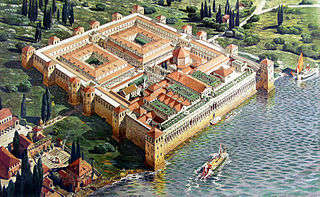
Walking route, Diocletian’s Palace, Split Croatia:
Palace Reconstruction Video
The entrance to the palace is free, however some of the sights require a ticket such as the Palace Underground (which I refer to as substrata), the Cathedral of Saint Dominus , the Treasury and Bell Tower (formerly Diocletian’s Mausoleum), and the Temple of Jupiter. Combined tickets are also available
Google maps show the outline of the palace in Split Croatia. On the street you will notice the stone walls that encompass the palace. There will be many small openings in this wall with narrow alleys ways to enter/exit the palace. At times you may not be able to tell the difference between what exists within the castle walls and that which is outside because the narrow cobblestone alleyways can unknowingly lead you to the outside of the castle
It can be confusing and many times tourist can be in the castle but wondering where the castle is. Using these alleyways is great way to explore once the self guided tour is completed
The destinations attraction for Split Croatia from the map below can be input as destinations into google maps if you want to follow along on your phone or you can print out the pdf. If you follow the destinations in the alphabetical order listed, they will take you on a specific walking route with the attractions (identified in green on the map) and walking route (identified in blue on the map). To access attractions, destination, and pdf; click on the button below or the icon on the title of the map:
To download interactive Split Croatia map click HERE
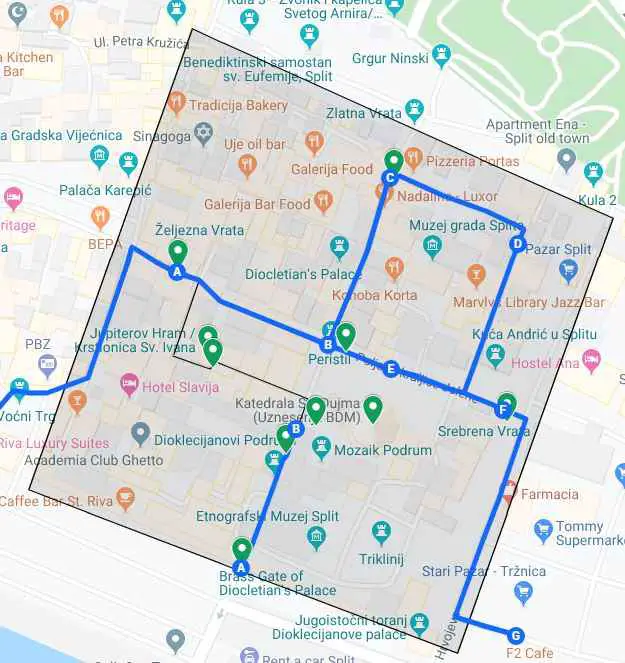
To download PDF map of Split Croatia click HERE
Bronze Gate
We will start the self guided walking tour at the entrance to the Bronze Gate (sometimes referred to as the Brass Gate). This entrance was used to access the palace from the sea. It opens from the sea into the basement substrata of the imperial family palace and apartments located above the substrata which face the sea.
Parts of the basement substrata are occupied by vendors and merchants while other parts of the basement cellar are used for art exhibitions. Notice the windows that are located close to the ceiling to prevent the water getting into this area should the seas rise. Over time the sea has receded exposing the land now used as the Riva promenade
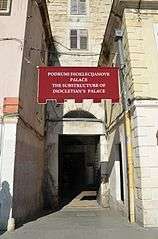
Basement Substrata
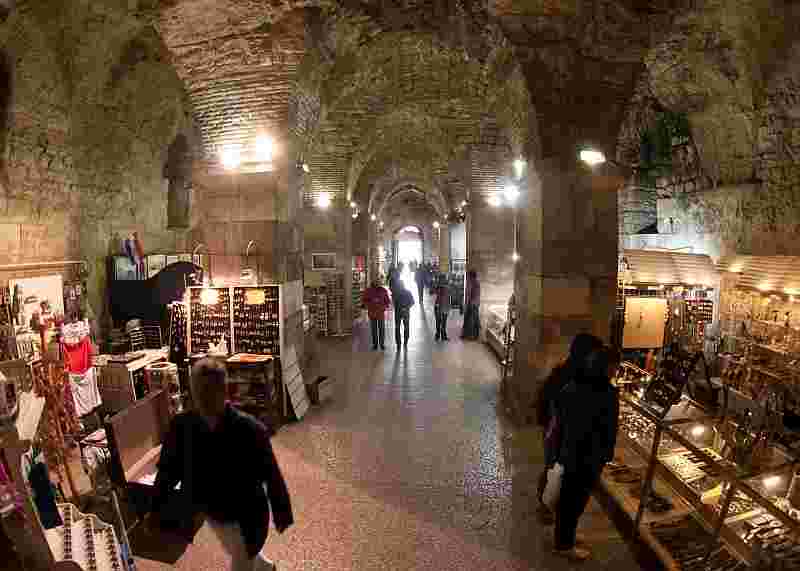
A tour of the cellars is available for about 40kn
The basement substrata was not only used as an entrance from the sea, it was also used to store food and wine. The citizens of nearby Solona took refuge in the castle substrata to escape from the invading Slavs. Eventually they left the basement substrata and moved upstairs into the main castle area. Over time they rebuilt and occupied the castle
During the rebuilding upstairs, the people made holes in the floor to be used for waste disposal and toilets. The waste and poop compacted over the years and preserved the basement perfectly which was later excavated
The palace apartments above the substrata have mostly disappeared and what remains are remnants of the castle enclosed by the castle wall structure. The substrata was used in the Game of Thrones series as Daenerys’ Throne Room and the area where the Dragons were kept
As you move through the basement cellars, you will exit the cellar by climbing a set of stairs that will lead you to the peristyle (main courtyard)
The Peristyle
The Peristyle is the Central Square of the palace which was used as a meeting place and a place to pay homage to the Emperor. It was also the location for formal ceremonies and a gathering place for the residents. The Peristyle is enclosed on three sides with an opening leading to the intersection of the two main streets named Cardo and Decumanus which formerly allowed residents easy access to the central square
- The Colonnades that surround the Peristyle are the darker columns lining it and were shipped from Egypt, as was the Sphinx. Many of the over a dozen Sphinx were destroyed in the 7th century as the inhabitants at that time felt they were pagan symbols. Only three of the Sphinx survived, in some cases with the heads cut off
- Diocletian’s mausoleum is located on the eastern side of the peristyle which was converted into a catholic cathedral in the 7th century and renamed the Cathedral and Bell Tower of St. Domnius, the Patron Saint of Split and the first Bishop of Salona
- On the western side of the peristyle, Emperor Diocletian built three temples of which only the Temple of Jupiter has survived
- Directly above the cellar basement stairs is the protyron and the vestibule. This was the Emperor’s access point from his royal apartments to the central square where he addressed his people
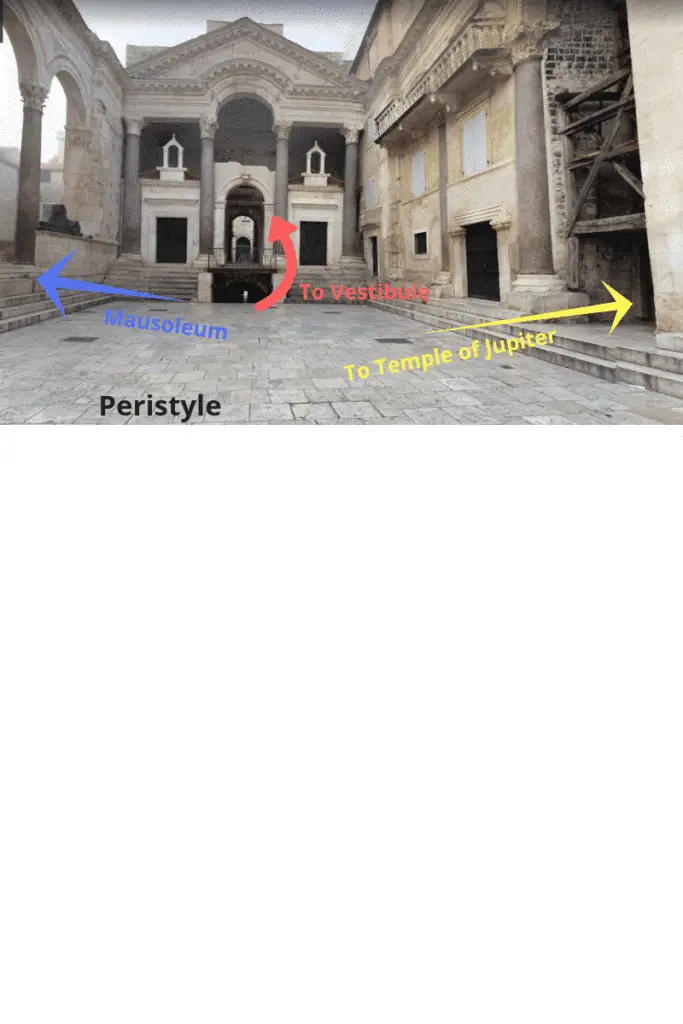
Vestibule
The Vestibule was the entrance to Diocletian’s apartment. Its square-shaped outside, circular-shaped inside and is accessed via the Peristyle. This circular room once led to the royal quarters and was decorated with marble slabs, mosaic tiles and statues. There used to be a cupola (a small dome) here but is now occupied by this large hole, open to the sky.
The acoustics are perfect for klapa singers, who are often found here performing a cappella harmonies and are a real treat if you happen to hear them
We sat for some time on the palace stairs listening to the klapa singers
Temple of Jupiter Passage way
To the west lies a tiny passageway called Kraj Svetog Ivana which you should use to access the only surviving temple, the Temple of Jupiter
- Use this passageway to make your way to the temple, it is not on google maps as its a tiny alley way
- For the next two attractions, Temple of Jupiter and Let Me Pass Street, follow the instructions listed below until you reach the Iron Gate. The passageways that take you to the iron gate are alleyways not on google maps and therefore you will need to follow the instructions below
Temple of Jupiter
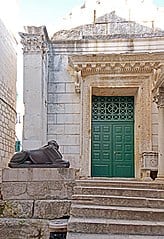
Built around the 3rd century, the Temple of Jupiter was dedicated to the Roman God of Sky and Thunder. Coincidentally Jupiter is also the name of Diocletian’s father. The Sphinx guarding the entrance was defaced by the Christians as it was considered a pagan symbol. After the fall of the Roman empire and during the middle ages, the temple became the Baptistery of the Cathedral.
To the left of the entrance, you will notice the tiniest passage way called Let Me Pass Street
Let me Pass Street, Ulica Pusti me proć’
This is one of the narrowest street in the world. It is wide enough to allow only one person to use the passage way at a time. This didn’t stop the younger generation from rubbing shoulders as they pass each other in this passageway while exchanging notes. It was a place where the young ladies hoped to meet potential suitors
- On the other side of Let me Pass Street is an open courtyard
- Walk down the “Let me Pass Street” to the open courtyard where you can stop for lunch or a coffee and enjoy the atmosphere before continuing
- When you are ready to move on, turn right at the end of the open courtyard, heading north down the alley towards the Iron Gate. The Iron Gate will be on your left as you approach the main street that leads to it. The main street is Kresimirova street (Ul. kralja Petra Krešimira on google maps)
The Iron Gate, Željezna vrata
Originally called Porta Occidentalis and renamed Porta Ferrea (Iron Gate), it was a free port of entry. It was made up of two parts, inner and outer gates which were used to trap individuals as they tried to seek asylum within the palace walls. Sometimes serving as a courtroom, this area was used to decide the fate of the individual caught between the two gates
Kresimirova street (Ul. kralja Petra Krešimira on google maps) was known as Cardo Decumanus during the time of Diocletian. Kresimirova/ Decumanus runs from the western Iron Gate to the eastern Silver Gate bisecting the palace
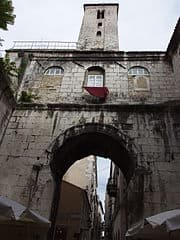
Church of St. Roche, Split, Croatia – located in Peristyle
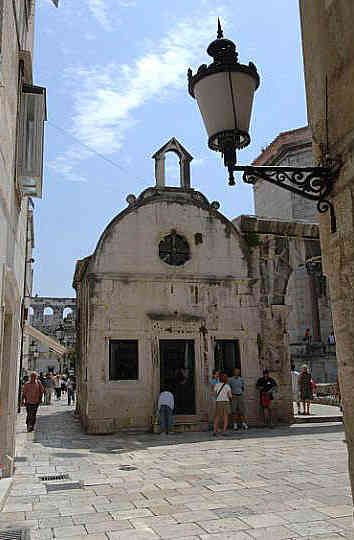
Saint Roch or Rocco (circca 1295-1327), was a catholic saint whose memory is celebrated on August 16 in Croatia and September 9 in Italy, He was called upon in prayer to save the people from the plague. The church itself with renaissance architecture, was created in 1516 by converting a 13th Century Roman House. While the original northern wall remains, the southern wall contains part of the colonnade of the portico of Diocletian’s Palace. Conveniently a Tourist Information Center is located nearby
Cado Decumanus, Cardo Maximus
In Roman times the street running east/west was called Decumanus and the street running north/south was called Maximus and the Persistyle is the intersection of these two streets. The streets were wide enough for a group of soldiers to walk or two chariots to ride. Today Decumanus is referred to as Kresimirova and Maximus is referred to as Dioklecijanova
Kinoteka Golden Gate, Zlatna Vrata
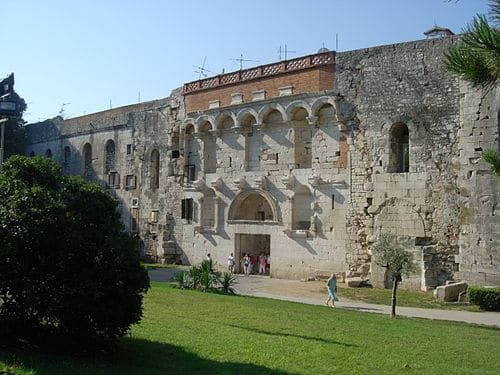
The Golden gate was reserved for the imperial family as it had direct access via the Cardo from the Emperors palace apartments to the nearby Roman capital city of Solona. The Emperor walked through this gate when he first entered the Palace on June 1, 305AD. The golden gate had double gates and was used as a human trap, trapping invaders between outer metal gate and the inner wooded gate
The archway is built without any nails and is considered to be an architectural feat. Note the four niches in the façade which housed a statute of the four regional rules – Diocletian, Maximian, Galerius and Constantius Chlorus
Outside of the gate stands the statue of Gregory of Nin, the 10th century bishop who opposed the Pope by holding church services into Croatian language. Rubbing his toe is supposed to bring good luck
Head south to Silver Gate along the eastern alley way
Explore the eastern side of the palace by walking east on Carrarina poljana (street on google maps) then south on Ul. Julija Nepota (street on google maps), use the store “Here Be Dragons, Games of Throne” marker on google maps to guide you to this walking route
Take your time on these streets as you leisurely explore and make your way south towards the Silver Gate. There are a couple of public toilets along the way, so look out for the signs
Diocletian’s Mausoleum – Cathedral and Bell Tower of St. Domnius (Sveti Duje)
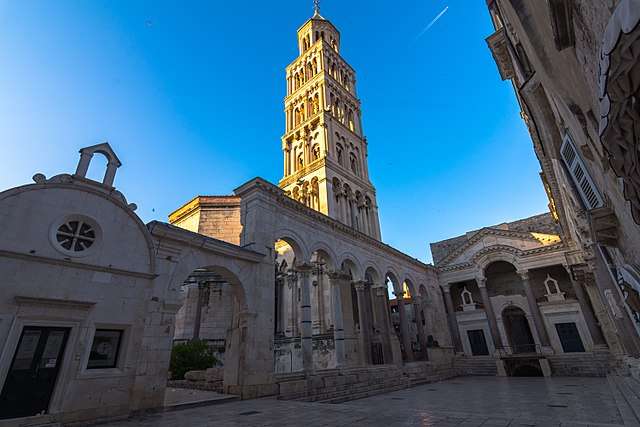
This was built as the final resting place of Emperor Diocletian. Many Romans had converted to Christianity by the 7th century and as a form of revenge on being persecuted during Diocletian’s reign, they converted his mausoleum into a cathedral and disposed of his remains. The Christians destroyed many of the Sphinx brought from Egypt as they considered them to be pagan symbols. Only three of the original dozen Sphinx remain. The Christians renamed the mausoleum after Saint Domnius, patron Saint of Split and the Bishop of Salona. The Bell Tower was built at a later date in the 13th century
Tickets can be purchased for the mausoleum and the bell tower. The view of Split from the bell tower is spectacular however the climb up is not for the faint of heart. Check out the staircase going up before purchasing tickets
Silver Gate, Srebrena Vrata
Originally called Porta Orientalis and renamed into Porta Argentea (Silver Gate), this is the eastern entrance to the palace. The gate was bricked up during the middles ages. It was reopend in the 1950 and restored to its original appearance and level. The look-out corridor above the gate was transformed into a church in the 6th century along with the lookout towers of the other gates
Most recently, this gate was used by Pope John Paul II when he paid a visit to Split in 2000. He passed through the gate in his “Popemobile” and drove along the wide Decumanus reminiscent of the emperor who rode the Decumanus in his chariot
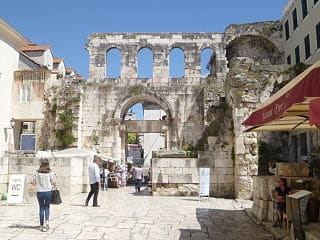
Once you have visited the Cathedral and Bell tower, exit the palace via the Silver Gate. Exiting the Silver Gate, you will see vendors selling souvenirs as well as the green market, described below
Take your time exploring the area as there is a lot to take in
Green Market
The stalls of the green market are full of products supplied by local produces who set up early in the morning. A variety of fresh fruit, flowers, vegetables, cheese, cured meats and local delicatessen products are displayed. The area is a bustle of activity in the morning, and dies down in the afternoon. We picked up some fresh food and sat on the benches on the Riva sea promenade and had a really nice snack break
Riva, location of the Tourist Information Center
Riva, located in front of Diocletian’s Palace, is a pedestrian heaven. It is full of cafes and restaurants and an ideal place for morning coffee, lunchtime snacks or a dinner destination in the evening.
It is the center of city life in Split, hosting cultural and entertainment events and it has been the scene of political rallies. Riva’s current look, reflects characteristic architectural features created during a period of French Rule in the early 19th century. The seafront promenade extends to the length of the old town and is 250 meters long and 55 meters wide. The best time to visit Riva is May 1 to May 13 when Sudamja The Feast of St. Domnius takes place. Then you will enjoy parades, concerts, theater performances, film screenings, exhibitions and events for children, traditional food and drink and a fireworks display. Something for everyone!
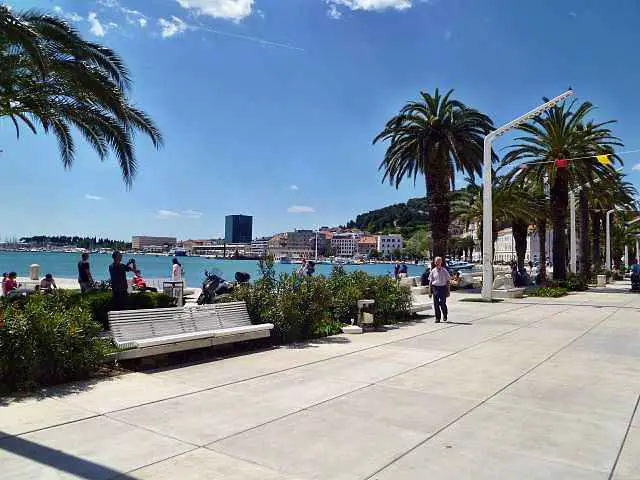
Croatia Travel Destinations and Guides
- Dubrovnik
- Dubrovnik Game of Thrones and Old Town Self Guided Tour – Follow the Map and Guide to visit the film locations for Game of Thrones, beaches and churches. The self guided tour will take you a full day if you also visit the beaches. Use the map and attractions guide to visit the attractions of Old Town Dubrovnik and the locations of the Games of Thrones Scenes. The map has picture of the sites and how they looked for the film scenes. The walking tour will take you ½ a day. If you visit Lokrum island and spend time at the beach/monastery/fort on the island, this will take you another ½ day to full day. Lokrum Island is the location of the City of Qarth in GoT and is a 10 min water taxi ride from the Dubrovnik Port
- Dubrovnik Day Trips. Spend a day at each of the villages of Ston and Cavtat a short distance from Dubrovnik. Cavtat is a charming village that was invaded by the Slavs. The inhabitants fled and were the original settlers of Dubrovnik. Visit the historical beaches and spend time on the beach or hike the Ronald Brown Pathway. Ston is a small village on a hill surrounded by a 7 km wall that is second in size to the Great Wall of China. It is famous for its defensive walls, its salt “mines” and its oyster bays. The oysters from Ston are well renowned
- Zagreb
- Upper Town, Old Town Zagreb – 15 must see attractions of Old Town Zagreb. Walk the attractions of Upper Town Zagreb, the self-guided walking tour will take you to the various attractions in ½ a day. You may want to explore some of these attractions in greater depth such as the Museum of Broken Relationships or climb the Lotrščak Tower. In that case the self guided tour will take more than half a day
- Zagreb Lower Town, Lenuci Horseshoe – Visit the 7 Squares and Botanical gardens in the shape of a horseshoe, including the under ground 31,000 sq meter shopping mall. A ½ day tour of the U-shaped system of 7 parks and Zagreb botanical gardens. The Lenuci horseshoe in Lower Town Zagreb is a short walking distance from Zagreb’s main Ban Jelačić Square and facing the main train station Glavni Kolodvor. The Square include pavilions, theater, museums, state archives and an underground mall amongst its many historical buildings dotted throughout the horseshoe
- Walking tour Zagreb Lower town and Grič Tunnels – A 2 hour tour of the tunnels under Zagreb old town; they were built as shelter during the war and are now used by the locals to cross Old Town or to go between upper town and lower town. Not only are they a short cut, they are cool in the summer and a welcome relief from the searing sun. Explore the old world war tunnels and visit the sights of lower town
- Unique and Fun things to do in Zagreb – Explore activities and places to visit such as Jarun Lake, the Antiques Fair or discover current events in Zagreb
- Split
- Old Town Split and Marjan Hill – Explore the Old Town Square, then head over to Marjan Hill. This self guided tour can take a whole day as the walking portion of the tour will guide you to attractions in the Old Town and then on to Marjan Hill. This part of the tour will take ½ a day. The tour will end at the beach where you can spend the rest of the day, take the local bus back or walk along the promenade back to Old Town
- Split, Salona ancient Roman Ruins – On the outskirts of Split, don’t miss the roman ruins of Salona, the birthplace of Emperor Diocletian. Step outside of the Old Town of Split and visit the nearby city of Solin (which is the ancient city of Salona, Diocletian’s birthplace). Then continue onto the town of Trogir. This self guided tour has instructions for local buses to take you on a route for a full day trip from Split to Salona (stop in Salona, then continue onto Trojir. Then catch the local bus back to Split
- Trogir, UNESCO World Heritage Site – This attraction is often overlooked. It is a charming, authentic village, a heritage city where the Old Town is on an Island. It is an easy bus ride from Split to Trogir, with a stopover in Salona (Solin)
- Split, Diocletian’s Palace – Not to be missed, the10 must see attractions in the palace to stop and take pictures. The Palace tour is a ½ day self-guided tour through the palace that will end at the market which you can explore
- Zadar
- Zadar Western Half – The old town is located on an island; explore the attractions on the westerns side of the island in this ½ day self guided walking tour. Attractions include popular attractions such as the Sea Organ, Greetings to the Sun and the Roman Forum / Ruins
- Zadar Eastern Half – Take a ½ day to visit the churches, parks and other attractions on the eastern side of Zadar Island. Visit the fish markets and green markets for fresh food and explore the cobblestone alleyways for a touch of ambiance and potential souvenir shopping
- Zadar islands – The Zadar Archipelago has around a 100 islands off its coast, many of them uninhabited. Visit all or any of the 9 popular islands in this map and use the attractions guide to the islands. You can rent a boat rent a boat with or without a captain, get a water taxi, take the ferry/ to visit the islands and swim in the Adriatic or anchor at hidden beach/cove
- Island Visit
- Croatia Islands – Rent or hire a boat to visit the 9 popular islands off the mainland. Visit 1 or 2 or all 9 islands for a fabulous day out to sea
- Hvar Island
- Hvar old town attractions and Španjola fortress (Fortica) – Use the self guided tour map and attractions to visit the popular sites in Hvar Old Town. The tour will take ½ a day to the major attractions in Hvar Town, including climbing to the Spanjola fortress that has been protecting Hvar for hundreds of years. However it could be longer if you want to spend time visiting the museums or spending an afternoon enjoying the magnificent views from the Fortress
- Hvar Island driving tour – Take the local bus, rent a car / scooter for the day to visit the numerous attractions on the island. This can take two days as there is a lot to see and do. It includes: wine tasting, visiting a cave monastery high on the hills, quaint fishing villages, popular beaches, hidden coves and harbours A great tour that will take you across the island
- Hvar Islands and Lavendar Fields Tour – You can rent a boat (with or without a captain) and visit the islands off Hvar Island. The Pakleni Islands are an archipelago of 20 islands off the coat of Hvar. They are known for beautiful beaches, charming village towns and secluded coves. You can take the bus to visit the abandoned villages of Velo Grabjle and Malo Grabjle,. It is a short bus ride or scooter/car trip from Hvar Town. Explore the fields of lavender and Olive Grove farms
- Getting around Croatia – Information on Croatian buses and ferries

